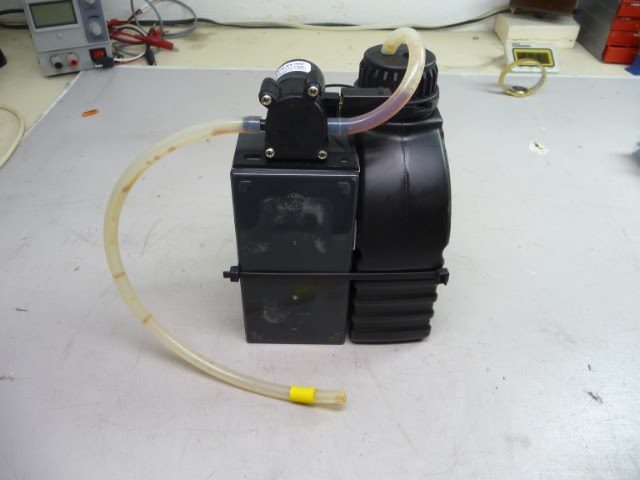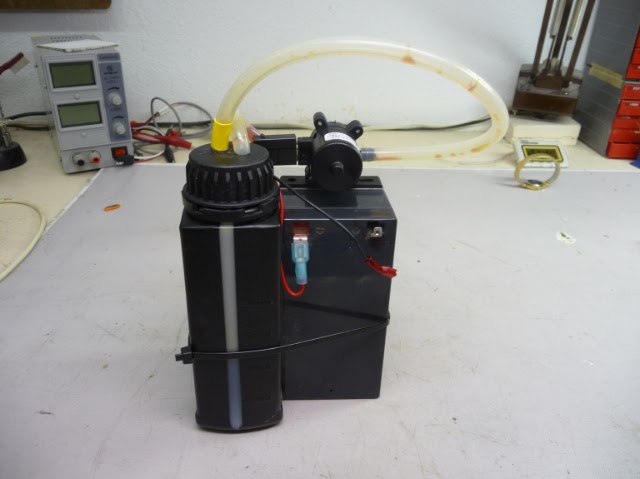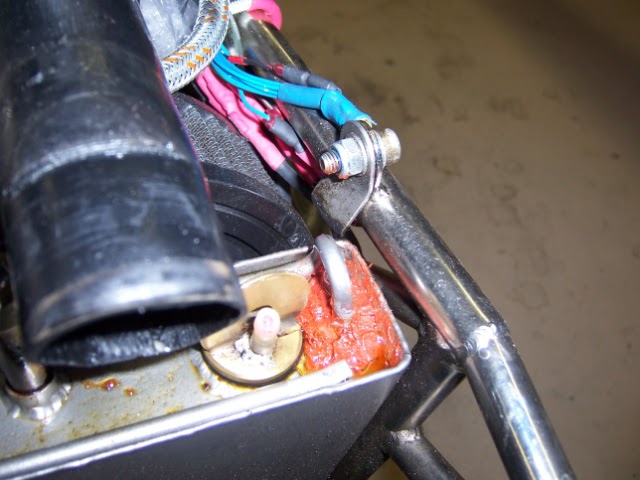Just before every flight, it is strongly advised to check the level of oil within its tank. Running the engine with a sufficient level of oil could severely damage the engine.
As the oil tank has a difficult access, it is not easy to turn it open. In addition, the oil is especially dirty ! You can trust me about this when my wife has to clean my clothes !

Eric Greenwell has developed a special method for filling the tank. I copy and paste his text hereunder.
[Nov. 2008] The oil is stored in a 1 quart plastic oil bottle, then pumped out as needed, using an oil pump screwed on the top of the bottle. The tubing makes it easy to direct the oil into the tank, and the milliliter markings that are molded into the side of the bottle let me determine how much oil is added.
To ensure I filled it to the same level every time, I slide a piece of tubing part way up the end of the oil tube. I set the end of this "marker" tubing on the edge of the oil tank opening, so the oil tube is always the same distance inside, and fill the tank to the end of the tubing. The pump delivers about 6 ml of oil per stroke, so typically 20-30 strokes does the job.
To prevent oil from leaking out the end of the oil tube when the pump isn't being using, I plug the end with small plastic plug, but small cork, golf tee, etc would work just fine.
The pump package was labeled "Valvoline Fluid Lubrication Pump" for quart size bottles, and was purchased at a Schucks Auto Store for about $6. I'm sure the same thing is available elsewhere.
[about a year later - added by Eric] The pump began to leak around the pump shaft, and it quickly became unusable, so I went to another method
[July 2013] Here's my current method, which is quick, clean, and easy.
I've tried several ways to add oil to the tank without getting a significant fraction of it on the engine, in the bay, or on myself. This method is the best I've tried yet.
It uses a model airplane oil pump (they use it to fill the smoke oil tank in the model airplane) to pump the oil from a Silkolene bottle into the 26 E oil tank. The left image shows the pump mounted on a small 12 volt, 4.5 AH SLA battery. The fill line is marked with a yellow band to show how far it should inserted into the tank opening. I stop filling when the oil in the tank reaches the end of the tube. The Silkolene bottle is held in place with bits of 3M gray double-stick tape and the nylon wire tie.

The right shows the other side, now with the fill line inserted in a hole in the cap for storage. I don't have a switch on it for now, simply holding the black wire connector onto the bare terminal. At 10 ml/sec, it takes only 20-30 seconds to top off my tank with the usual 200-300 ml.
If you like this idea, order a pump Real Soon Now, because it's been discontinued, and it's disappearing from the shelves. I got mine from Tower Hobbies ...
TowerHobbies.com | TME Smoke Oil Electric Field Pump
There may be other suitable pumps, of course.
[Bruno continues] Personally, I am using a big medical syringe with a plastic tube I put inside the tank. My method is clean but the pressure to apply on the syringe with the fingers is high because the oil is rather viscous.
How much to we need to fill in the tank?
Usually, I am filling it till the level of oil reaches about 1 cm below the top. I know that some pilots fill it up to the top. Now, I have often oil flowing through the venting tube. This lead to a situation where the oil is accumilating on top of the tank. I don't like this because the tank seems very dirty.
Heini Schaffner (CH) made an interesting widget. He proposed to add on the venting tube a gasoline filter for preventing oil to accumulate on top of the tank.
Notes:
Eric reports: The first few years I flew my glider, I never had oil on the top of the tank; later, the oil appeared, even if I only filled the 3 cm below the top. Finally, I discovered the mounting tab on the top, right side of the tank had broken off. Only the engine mounting bolt held it in place. After the mounting tab was repaired, I no longer have oil appear on top of the tank (the red material is RTV I used when I thought there might be a small hole at the base of the vent tube weld).

